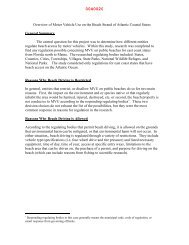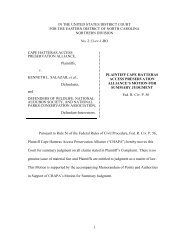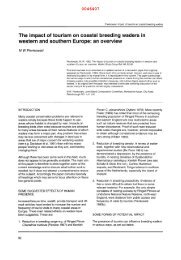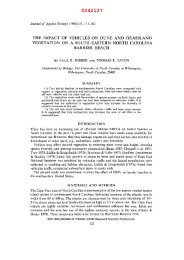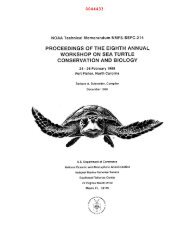Disorientation of Loggerhead Hatchlings by Artificial Road Lighting ...
Disorientation of Loggerhead Hatchlings by Artificial Road Lighting ...
Disorientation of Loggerhead Hatchlings by Artificial Road Lighting ...
You also want an ePaper? Increase the reach of your titles
YUMPU automatically turns print PDFs into web optimized ePapers that Google loves.
<strong>Disorientation</strong> <strong>of</strong> <strong>Loggerhead</strong> <strong>Hatchlings</strong> <strong>by</strong> <strong>Artificial</strong> <strong>Road</strong> <strong>Lighting</strong><br />
Robert W. McFarlane<br />
0040398<br />
Copeia, Vol. 1963, No. 1. (Mar. 30, 1963), p. 153.<br />
Stable URL:<br />
http://links.jstor.org/sici?sici=0045-8511%2819630330%293%3A1963%3A1%3C153%3ADOLHBA%3E2.0.CO%3B2-X<br />
Copeia is currently published <strong>by</strong> American Society <strong>of</strong> Ichthyologists and Herpetologists.<br />
Your use <strong>of</strong> the JSTOR archive indicates your acceptance <strong>of</strong> JSTOR's Terms and Conditions <strong>of</strong> Use, available at<br />
http://www.jstor.org/about/terms.html. JSTOR's Terms and Conditions <strong>of</strong> Use provides, in part, that unless you have obtained<br />
prior permission, you may not download an entire issue <strong>of</strong> a journal or multiple copies <strong>of</strong> articles, and you may use content in<br />
the JSTOR archive only for your personal, non-commercial use.<br />
Please contact the publisher regarding any further use <strong>of</strong> this work. Publisher contact information may be obtained at<br />
http://www.jstor.org/journals/asih.html.<br />
Each copy <strong>of</strong> any part <strong>of</strong> a JSTOR transmission must contain the same copyright notice that appears on the screen or printed<br />
page <strong>of</strong> such transmission.<br />
The JSTOR Archive is a trusted digital repository providing for long-term preservation and access to leading academic<br />
journals and scholarly literature from around the world. The Archive is supported <strong>by</strong> libraries, scholarly societies, publishers,<br />
and foundations. It is an initiative <strong>of</strong> JSTOR, a not-for-pr<strong>of</strong>it organization with a mission to help the scholarly community take<br />
advantage <strong>of</strong> advances in technology. For more information regarding JSTOR, please contact support@jstor.org.<br />
http://www.jstor.org<br />
Tue Jan 29 09:13:46 2008
DISORIENTATION OF LOGGER-<br />
HEAD HATCHLINGS BY ARTIFICIAL<br />
ROAD LIGHTING.-The detrimental effects<br />
<strong>of</strong> civilization on the breeding success<br />
<strong>of</strong> sea turtles nesting on beaches adjacent to<br />
populated areas is well known. An additional<br />
factor was recently observed which<br />
apparently causes disorientation in the tur-<br />
tle hatchlings, <strong>of</strong>ten inflicting a high mortality.<br />
The Atlantic loggerhead sea turtle, Caretta<br />
caretta, commonly nests on the beaches<br />
<strong>of</strong> southeast Florida. During late summer<br />
months, loggerhead hatchlings are frequently<br />
observed in large numbers on high-<br />
ways which parallel the beaches and many<br />
hundreds <strong>of</strong> these turtles are killed <strong>by</strong> pass-<br />
ing automobiles. Investigation <strong>of</strong> a concentration<br />
<strong>of</strong> freshly killed turtles in such an<br />
instance produced rather<br />
The nest was found On August<br />
lg62* the having emerged the preceding<br />
night. The nest was located at the<br />
northern end <strong>of</strong> the public bathing beach at<br />
Ft. Lauderdale, Florida, on North Atlantic<br />
Boulevard and Northeast 18th Street, an<br />
area <strong>of</strong> resort hotels. The nest was a scant<br />
35 feet from the high tide line and approxi-<br />
mately 100 feet from the highway. The<br />
clutch consisted <strong>of</strong> 130 eggs, 115 or 88.4 per<br />
cent <strong>of</strong> which had hatched. The 15 unhatched<br />
eggs included which were infertile.<br />
Of the 115 hatchlings, 1 found one<br />
dead and two live hatchlings in the nest<br />
several inches beneath the surface; one<br />
dead (from desiccation) hatchling near the<br />
road; and 90 hatchlings which could reasonably<br />
be assigned to this particular nest<br />
dead on the adjacent highway, the majority<br />
having been crushed <strong>by</strong> automobiles.<br />
Examination <strong>of</strong> the tracks left <strong>by</strong> the<br />
turtles as they dispersed from the nest indi-<br />
cated that the vast majority had proceeded<br />
westward, up the slope, to the highway,<br />
fanning out as the distance from the nest<br />
increased. Only six turtles had proceeded<br />
directly to the water a short distance away.<br />
A number <strong>of</strong> others which had initially<br />
started in the wrong direction had eventu-<br />
ally circled and entered the water, bringing<br />
the total number <strong>of</strong> turtles which apparently<br />
reached the surf to 20.<br />
Work with hatchlings <strong>of</strong> all the genera <strong>of</strong><br />
sea turtles has revealed a strong and con-<br />
0040399<br />
HERPETOLOGICAL NOTES<br />
sistent capacity to find the sea under a wide<br />
variety <strong>of</strong> conditions, both natural and<br />
manipulated. <strong>Loggerhead</strong>s have been shown<br />
to be positively geotrophic and phototaxic,<br />
repelled <strong>by</strong> a broken horizon and attracted<br />
<strong>by</strong> a low unbroken horizon (Carr and<br />
Ogren, 1960, Bull. Am. Mus. hTat. Hist. 121<br />
[1]:1-48). Yet 95 per cent <strong>of</strong> the turtles<br />
which emerged from this nest were unable<br />
to orient correctly and find the surf. It<br />
appears that the combined effect <strong>of</strong> the<br />
illuminated sky over Ft. Lauderdale and a<br />
mercury vapor street light approximately<br />
150 feet beyond the nest provided sufficient<br />
attraction to overcome normal taxes. Further<br />
investigation <strong>of</strong> 16 miles <strong>of</strong> beach along<br />
Highway U. S. A1A revealed turtles on the<br />
road at many places where they had traveled<br />
relatively great distances over concrete<br />
and asphalt between closely spaced hotels<br />
and apartments. Areas without turtles on<br />
the road had strips <strong>of</strong> scrub vegetation between<br />
beach and road. No turtles were<br />
noted at the bathing area <strong>of</strong><br />
Beach, where there is little artificial illumination.<br />
The disastrous effect <strong>of</strong> these rapidly developing<br />
resort areas adjacent to nesting<br />
beaches, which in this instance reduced the<br />
success <strong>of</strong> emerging hatchlings reaching the<br />
water to 18 per cent, further emphasizes the<br />
providing protected<br />
areas for sea turtles. One need only travel<br />
the shorelines <strong>of</strong> these beach resorts counting<br />
the hundreds <strong>of</strong> turtle carcasses to realize<br />
that this case is not an isolated example.<br />
-ROBERT W. ~~CFARLANE, DePt. <strong>of</strong> Biology,<br />
University <strong>of</strong> Florida, Gainesuille, Florida.<br />
153<br />
MUSCLES IN THE REGION OF THE<br />
EUSTACHIAN TUBE OF TURTLES:<br />
TWO CORRECTIONS.-Previously,<br />
hlcDowel1 (1961, Bull. Mus. Comp. Zool.<br />
125[2]:28) has described a muscle in turtles<br />
that extends downward and forward from<br />
the rear <strong>of</strong> the opisthotic to insert on the<br />
operculum tubae (a pad <strong>of</strong> densely fibrous<br />
connective tissue on the rear wall <strong>of</strong> the<br />
Eustachian tube). This muscle, termed the<br />
musculus dilator tubae, was stated to be "a<br />
branch <strong>of</strong> the depressor mandibulae muscle."<br />
Further dissection proves homology <strong>of</strong> the<br />
dilator tubae with the depressor mandibulae




